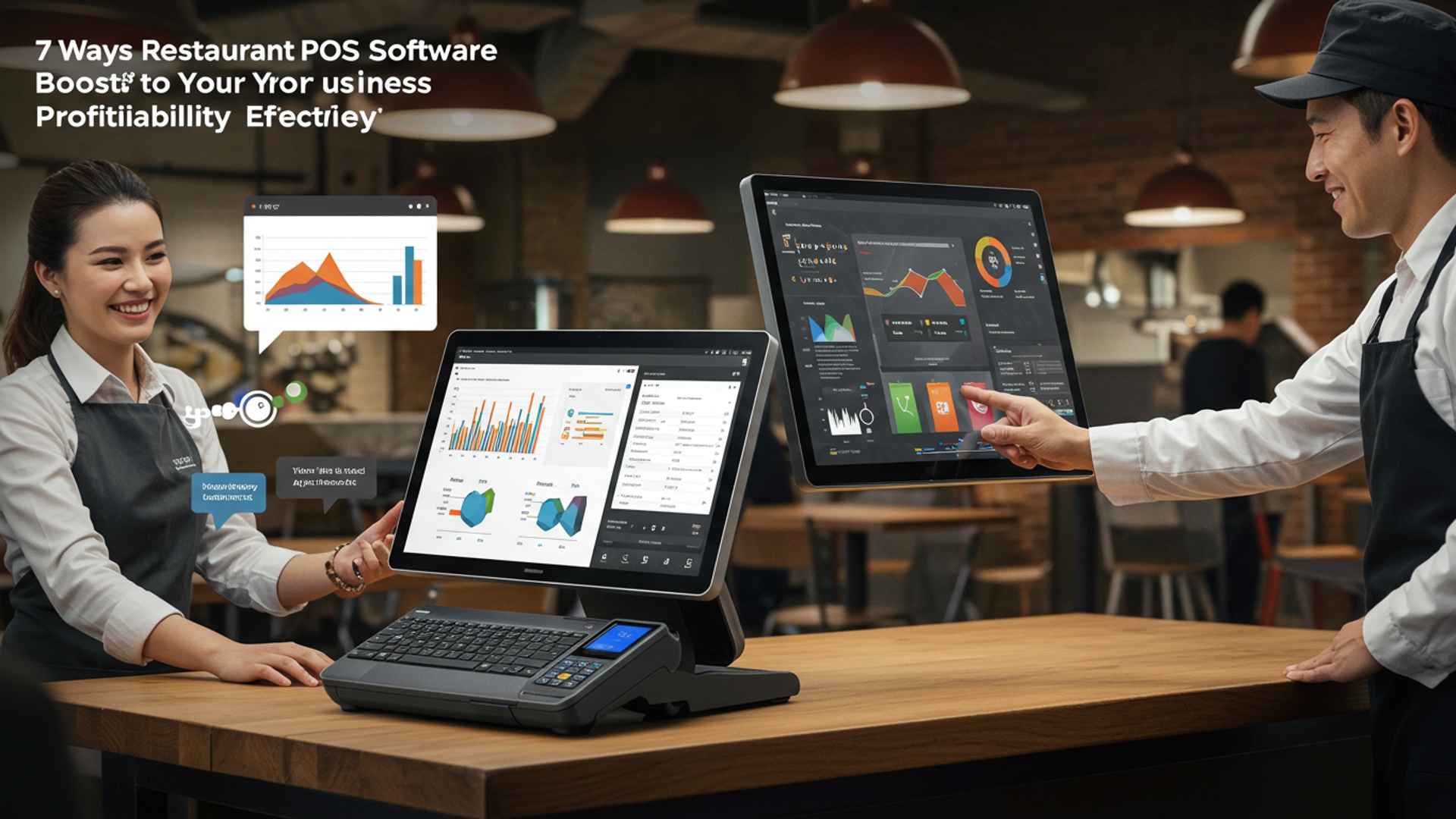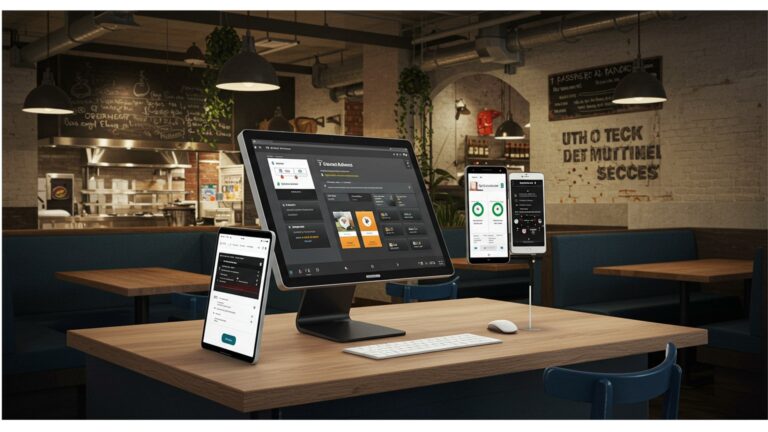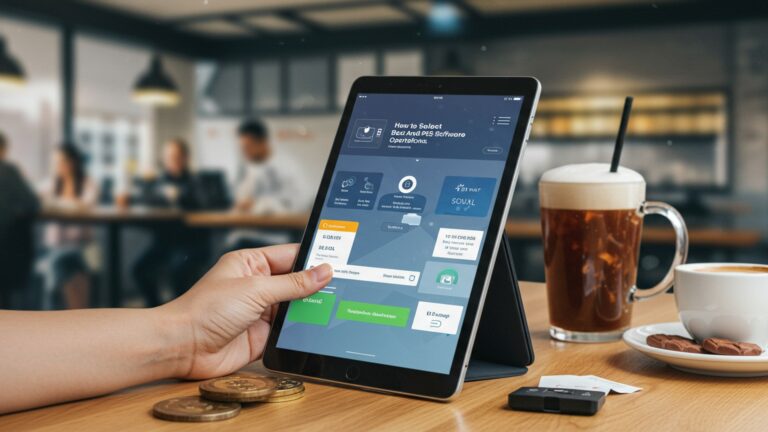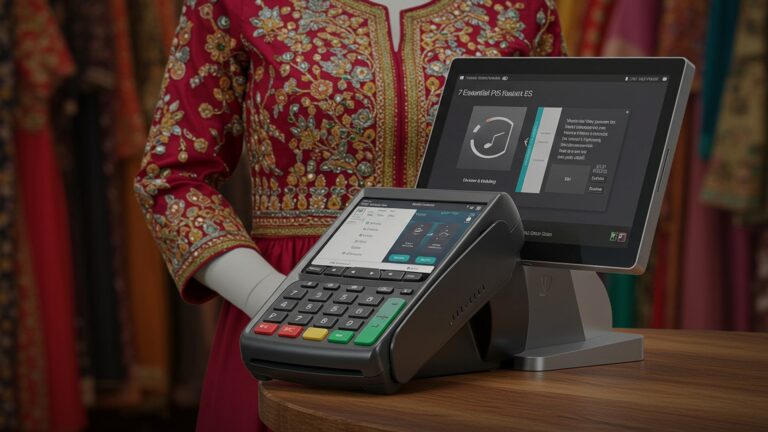7 Ways Restaurant POS Software Boosts Your Business Profitability Effectively
Restaurant profitability in today’s dynamic market demands more than just exceptional cuisine; it requires operational precision. Modern restaurant POS software has transformed from a simple cash register into a sophisticated operational hub, directly influencing your bottom line. It seamlessly integrates real-time inventory management, preventing costly food waste, with efficient online order processing and secure contactless payment solutions. By leveraging the advanced analytics derived from your POS, you can precisely identify high-profit menu items, optimize staff scheduling. eliminate inefficiencies like manual order errors. This comprehensive system empowers operators to significantly enhance customer experiences and drive substantial revenue growth in an increasingly competitive landscape.

1. Streamlined Order Management and Enhanced Accuracy
At the heart of any successful restaurant operation lies efficient order management. Manual processes, while seemingly cost-effective initially, are breeding grounds for errors, delays. frustrated customers. This is where modern Restaurant POS software truly shines, transforming the chaotic dance of order taking into a smooth, synchronized ballet.
A Point of Sale (POS) system, in essence, is a centralized hub where all transactions and operational data converge. For restaurants, this means taking orders, processing payments, managing tables. even communicating with the kitchen or bar, all from a single, integrated platform. When an order is placed through a Restaurant POS software, it’s immediately and accurately sent to the respective preparation stations (kitchen display systems or printers), minimizing miscommunications that often lead to incorrect dishes or lengthy wait times.
Consider a bustling Friday night service in a mid-sized bistro. Without a robust Restaurant POS software, a server might scribble down a complex order, potentially mishearing a dietary restriction or a specific modification. This handwritten note then travels to the kitchen, where another human error could occur during interpretation. The result? A re-fired dish, wasted ingredients. a customer waiting unnecessarily. With a POS system, the order is digitally entered, modifications are clearly selected from pre-defined options. the exact data is relayed instantly. This drastically reduces the incidence of order errors, leading to less food waste and higher customer satisfaction.
- Reduced Errors: Digital entry minimizes miscommunication between front-of-house and back-of-house.
- Faster Service: Orders are instantly transmitted, speeding up preparation and delivery times.
- Improved Customer Experience: Accurate orders mean happier customers, leading to repeat business and positive reviews.
- Less Waste: Fewer incorrect orders equate to less food being thrown away, directly impacting your bottom line.
2. Enhanced Inventory Control and Waste Reduction
Food costs are a significant portion of a restaurant’s operational expenses. Without precise control, inventory can become a silent drain on profitability through spoilage, over-ordering, or even internal theft. A comprehensive Restaurant POS software offers powerful tools for real-time inventory management, giving you unprecedented visibility and control over your ingredients.
Traditional inventory management often involves manual counts, spreadsheets. educated guesses – a laborious and error-prone process. A modern Restaurant POS software, But, integrates sales data directly with inventory levels. Every time an item is sold, the system automatically deducts the corresponding ingredients from your inventory. For example, if a “Classic Burger” is sold, the system might deduct 1 burger patty, 1 bun, 2 slices of tomato, etc. , based on your pre-defined recipes.
This level of detail allows for:
- Real-time Tracking: Know exactly what you have in stock at any given moment, across all ingredients.
- Automated Reordering: Set minimum stock levels. the system can alert you or even automatically generate purchase orders when supplies run low, preventing stockouts and over-ordering.
- Waste Monitoring: By tracking ingredient usage against sales, you can identify areas of waste, spoilage, or even potential theft. This helps in understanding actual food cost percentages more accurately.
- Optimized Purchasing: Make data-driven decisions on purchasing quantities, negotiating better deals with suppliers. reducing holding costs.
Consider a café that sells a popular avocado toast. If avocados are consistently over-ordered due to poor tracking, the café might face significant spoilage, especially if sales fluctuate. A Restaurant POS software would track avocado usage daily, forecast demand based on historical sales. recommend optimal purchasing quantities, ensuring freshness and minimizing waste.
Here’s a quick comparison of manual vs. POS inventory:
| Feature | Manual Inventory | Restaurant POS Software Inventory |
|---|---|---|
| Accuracy | Prone to human error, often estimates | High accuracy, real-time updates |
| Time Required | Labor-intensive, weekly/monthly counts | Automated deductions, quick audits |
| Waste Identification | Difficult to pinpoint sources of waste | Clear visibility into discrepancies |
| Reordering | Subjective, often reactive | Proactive, data-driven suggestions |
| Cost Savings | Limited potential | Significant due to waste reduction & optimized purchasing |
3. Optimized Labor Management
Labor costs often represent the second-largest expense for restaurants, right after food costs. Managing staff effectively—from scheduling to performance—is crucial for maintaining profitability. A sophisticated Restaurant POS software can become an invaluable tool in optimizing your labor force.
Many Restaurant POS software systems come equipped with integrated labor management features that allow you to:
- Track Employee Hours Accurately: Employees can clock in and out directly through the POS, eliminating manual time cards prone to errors or “buddy punching.” This provides precise data for payroll and ensures compliance with labor laws.
- Monitor Staff Performance: Link individual staff members to their sales performance. Identify your top sellers, interpret peak performance times. recognize areas where additional training might be beneficial. For instance, you can see which server consistently upsells desserts or drinks.
- Optimize Scheduling: By analyzing sales data from the Restaurant POS software, you can identify your busiest hours and days. This allows you to create more efficient schedules, ensuring adequate staffing during peak times and reducing unnecessary labor during slower periods. For example, if your data shows Tuesdays from 2 PM to 5 PM are consistently slow, you can adjust staffing levels accordingly, reducing overtime and optimizing your wage spend.
- Forecast Labor Needs: Advanced Restaurant POS software can use historical sales data to project future demand, helping you forecast labor needs more accurately and prepare schedules well in advance.
Consider a popular downtown eatery. Before implementing a Restaurant POS software with labor management features, the manager might have scheduled staff based on general intuition, often leading to overstaffing during slow lunch shifts and understaffing during peak dinner rushes, resulting in either wasted wages or lost sales due to slow service. With the POS system, they can pull up reports showing sales per hour, per day. per server. This data empowers them to create a lean, efficient schedule that minimizes labor costs while maximizing service quality, directly boosting profitability.
4. Data-Driven Decision Making
In today’s competitive restaurant landscape, relying solely on intuition is a recipe for missed opportunities. A robust Restaurant POS software transforms raw transactional data into actionable insights, enabling owners and managers to make informed, strategic decisions that drive profitability.
Your POS system is a treasure trove of data. It meticulously records every transaction, every order, every payment method. every inventory movement. This data, when analyzed, can reveal powerful trends and patterns. Key analytical capabilities include:
- Sales Reports: comprehend what’s selling, when it’s selling. who’s buying it. Identify peak hours, best-performing dishes. popular combinations.
- Menu Engineering: examine the profitability and popularity of each menu item. This allows you to identify “stars” (high profit, high popularity) to promote, “plows” (high profit, low popularity) to re-evaluate, “puzzles” (low profit, high popularity) to adjust pricing. “dogs” (low profit, low popularity) to remove. This strategic menu design directly impacts your profit margins.
- Customer Insights: Track customer preferences, average spend. visit frequency, especially when integrated with loyalty programs.
- Operational Efficiency Metrics: Monitor table turnover rates, average order value. server performance.
Imagine a pizzeria owner who notices, through their Restaurant POS software reports, that while their signature “Deluxe Meat Lover’s” pizza is popular, its profit margin is significantly lower than a simpler “Margherita” due to ingredient costs. Armed with this data, they might decide to slightly increase the price of the Meat Lover’s, or introduce a premium version with higher-quality, higher-margin ingredients, while actively promoting the Margherita through combo deals. This isn’t guesswork; it’s a precise adjustment based on solid data.
This capability moves you from reactive management to proactive strategy. Instead of wondering why sales are down, you can pinpoint specific dishes that aren’t performing, identify slow periods for targeted promotions, or recognize the need for staff training in specific areas. This data-driven approach is fundamental to maximizing profitability in a dynamic market.
5. Improved Customer Experience and Loyalty Programs
In the experience economy, customer satisfaction isn’t just a nicety; it’s a direct driver of repeat business and positive word-of-mouth. A sophisticated Restaurant POS software plays a pivotal role in enhancing the overall customer experience and fostering loyalty.
How does it achieve this?
- Faster and More Accurate Service: As discussed earlier, streamlined order taking and kitchen communication mean less waiting and fewer mistakes. A smooth, efficient dining experience leaves a positive impression.
- Personalized Experiences: Integrated CRM (Customer Relationship Management) features within some Restaurant POS software allow you to store customer preferences, dietary restrictions. past orders. Imagine a returning customer being greeted with “Welcome back! Would you like your usual latte with almond milk?” This level of personalization creates a memorable experience.
- Seamless Payment Options: Modern Restaurant POS software supports a variety of payment methods, including EMV chip cards, contactless payments (NFC), mobile wallets (Apple Pay, Google Pay). even QR code payments. Offering convenience at checkout reduces friction and enhances satisfaction.
- Integrated Loyalty Programs: Many Restaurant POS software systems offer built-in or integrated loyalty modules. Customers can earn points, receive discounts, or get special offers directly linked to their purchases. This incentivizes repeat visits. For example, a coffee shop might offer a free pastry after every 10 coffee purchases, all tracked effortlessly by the POS.
- Feedback Collection: Some systems allow for quick feedback collection at the point of sale or via digital receipts, giving you immediate insights into customer sentiment and areas for improvement.
Consider a local diner that implemented a loyalty program through their Restaurant POS software. Customers signing up receive a small discount on their first purchase and then accrue points for every dollar spent. The system automatically tracks these points and notifies customers when they’re eligible for rewards. This not only encourages repeat visits but also provides the diner with valuable data on their most loyal patrons, allowing for targeted marketing and special promotions, ultimately driving long-term profitability.
6. Enhanced Fraud Prevention and Security
Restaurants, dealing with cash, credit card transactions. a fluctuating staff, can be vulnerable to various forms of fraud, both internal and external. A robust Restaurant POS software acts as a critical line of defense, safeguarding your revenue and operational integrity.
Here’s how Restaurant POS software bolsters security:
- Audit Trails and Transaction Logs: Every action performed on the POS—every order taken, every payment processed, every void, discount, or refund—is meticulously recorded. This creates a comprehensive audit trail, allowing managers to review past transactions and identify any suspicious activity.
- User Permissions and Access Levels: Restaurant POS software allows you to set specific user roles and permissions. For example, a server might only be able to take orders and process payments, while a manager has the authority to issue refunds or apply discounts. This restricts access to sensitive functions, preventing unauthorized actions.
- Void and Discount Tracking: These are common areas for internal fraud. The POS system can require manager approval for voids or large discounts. all such actions are logged with details on who performed them and why. This transparency significantly reduces opportunities for employees to manipulate transactions for personal gain.
- Cash Management: Integrated cash drawer management features track cash inflows and outflows, making it easier to reconcile cash at the end of a shift and identify discrepancies.
- PCI DSS Compliance: Modern Restaurant POS software solutions are designed to comply with Payment Card Industry Data Security Standard (PCI DSS) regulations, ensuring that sensitive customer credit card data is handled securely, reducing the risk of data breaches and associated penalties.
A real-world scenario highlights this. A busy bar manager noticed discrepancies in their end-of-day cash reports. By leveraging the audit logs in their Restaurant POS software, they were able to trace back specific shifts where cash was short. The logs revealed a pattern of excessive “no-sale” transactions and voids performed by a particular bartender, allowing the manager to address the issue directly and prevent further losses. Without the detailed logging of the Restaurant POS software, such internal theft might have gone unnoticed for much longer, significantly eroding profitability.
7. Scalability and Multi-Location Management
For restaurant businesses with ambitions to grow or those already managing multiple outlets, the right Restaurant POS software is not just an operational tool but a strategic asset. It provides the infrastructure needed to scale efficiently and maintain consistency across all locations, directly impacting long-term profitability.
Here’s how Restaurant POS software supports scalability and multi-location management:
- Centralized Management: A cloud-based Restaurant POS software allows owners or managers to oversee all aspects of their business from a single dashboard, regardless of physical location. This includes managing menus, pricing, promotions, inventory. staff across multiple restaurants. No more traveling to each location to update a menu item or check inventory levels.
- Consistent Operations: Ensure a uniform customer experience and operational standards across all your establishments. A centralized system means that menu updates, price changes, or new promotions can be pushed out to all locations simultaneously, ensuring brand consistency.
- Consolidated Reporting: Gain a holistic view of your entire enterprise. Restaurant POS software can generate consolidated sales reports, inventory reports. labor reports for all locations, providing invaluable insights into overall performance and helping identify top-performing and underperforming outlets.
- Simplified Expansion: When opening a new location, setting up a new POS terminal and integrating it into the existing system is far more straightforward than establishing an entirely new, independent setup. This reduces setup time and costs, making expansion more efficient and less daunting.
- Streamlined Employee Management: Manage employee profiles, schedules. payroll across all locations from a central hub, simplifying HR tasks and ensuring compliance.
Consider a successful local bakery that decides to expand into two new neighborhoods. Without a unified Restaurant POS software, they would have to manage three separate inventory systems, three different menu update processes. three distinct reporting systems. This would be incredibly time-consuming, prone to error. make it difficult to compare performance or implement group-wide promotions. With a robust cloud-based Restaurant POS software, they can manage all three locations seamlessly from their central office, ensuring consistent quality, efficient operations. rapid, profitable expansion.
Conclusion
Ultimately, embracing advanced restaurant POS software isn’t merely an upgrade; it’s a strategic investment in your business’s future profitability. As we’ve explored, from streamlining operations like order management and inventory control to enhancing customer experiences through loyalty programs and integrated online ordering, the impact is profound. My personal tip? Don’t just install it; truly master its analytics features. I’ve personally witnessed how a simple dive into sales reports and peak hour data can uncover hidden opportunities, like optimizing staff schedules to reduce labor costs by 10% or identifying best-selling items to refine your menu. Modern POS systems, leveraging current trends in cloud computing and mobile accessibility, offer unprecedented insights into your restaurant’s pulse. Instead of viewing your POS as just a transaction terminal, see it as a powerful data engine that can guide every decision, from preventing food waste through precise inventory tracking to boosting average check sizes by suggesting popular add-ons. The time for hesitation is over; the actionable step is to thoroughly research and implement a system that aligns with your unique needs. If you’re wondering where to start, consider exploring How to Choose the Right Restaurant POS to set your business on an accelerated path to success. The future of your restaurant’s profitability is literally at your fingertips.
More Articles
Avoid These 6 Common Mistakes When Implementing New Restaurant POS Software Solutions
10 Essential Restaurant POS Features Every Owner Needs to Master
Learn 8 Best Practices for Maximizing Your Restaurant POS System Investment Today
The Ultimate Guide 8 Key Benefits of Modern Restaurant POS Software
FAQs
How does a restaurant POS system actually make my operations smoother and save me money?
It streamlines everything! From quick order taking and sending to the kitchen, to accurate billing and table management. This means faster service, fewer mistakes. less time spent on manual tasks, freeing up your staff and reducing operational costs.
Can POS software really help me stop wasting food and ingredients?
Absolutely. A good POS tracks your inventory in real-time. You’ll know exactly what’s selling, what’s running low. what’s nearing expiration. This helps you order smarter, minimize spoilage. reduce food waste, directly impacting your bottom line.
What kind of insights can I get from POS reports to make smarter business decisions?
You get a treasure trove of data! POS reports can show you your most popular dishes, peak sales hours, best-performing staff. daily/weekly/monthly sales trends. This details is crucial for optimizing menus, staffing levels. marketing efforts to boost profitability.
How does a POS system help me keep my customers happy and coming back?
Many POS systems include features for customer relationship management (CRM). You can track customer preferences, run loyalty programs. offer personalized discounts. Happy, loyal customers mean repeat business and consistent revenue.
Does using POS software mean fewer order mistakes and happier staff?
Definitely. By automating order entry and sending them directly to the kitchen, you drastically reduce human error. This leads to correct orders, less food waste from remakes. a smoother workflow for your team, reducing stress and improving staff morale.
How does a modern POS simplify handling payments and improve security?
It integrates various payment options seamlessly – credit cards, mobile payments, gift cards – all securely processed. This speeds up checkout, reduces reconciliation errors. often comes with enhanced security features to protect both your business and customer data.
In the end, how does all this automation and data actually put more money in my restaurant’s pocket?
By combining all these benefits – reduced operational costs, minimized waste, optimized staffing, increased sales through better insights and customer loyalty. fewer errors – a POS system creates a more efficient and profitable business model. It’s about working smarter, not just harder, to boost your profit margins significantly.




